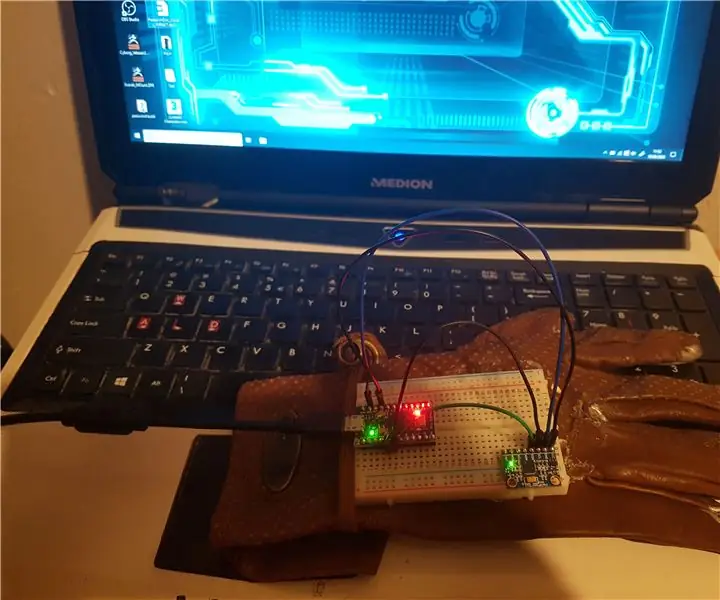
Table des matières:
- Auteur John Day [email protected].
- Public 2024-01-30 09:06.
- Dernière modifié 2025-01-23 14:45.
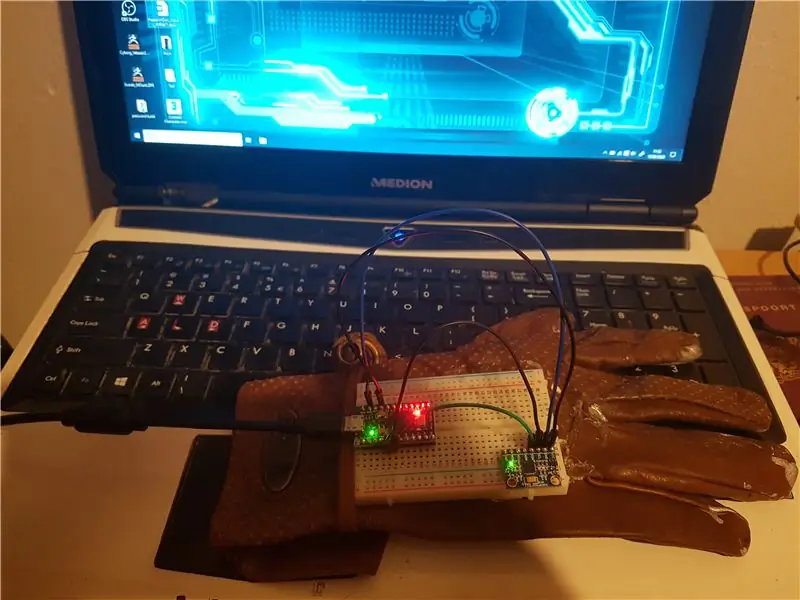
Een handschoen die je kan gebruiken als motion controller voor on-rail shooters. De gimmick van dit project is dat alles motion control is, inclusief het schieten. (Je schiet porte te "finger bangen")
Étape 1: Het matériel
Het materiaal dat je gaat nodig hebben is vrij simpel. 1x Arduino pro micro d'Arduino Leonardo1x gyroscope MPU6050
4x câbles
Étape 2: De Bekabeling
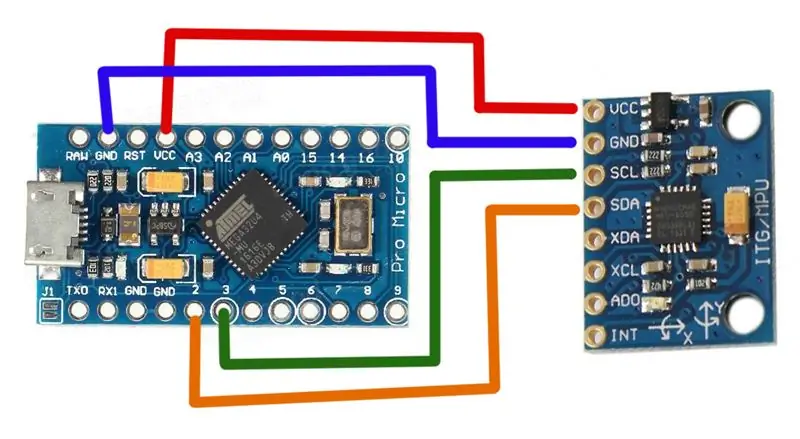
Zoals je in het schema in de afbeelding ziet est de bekabeling super simpel. MPU VCC > masse Arduino VCCMPU > masse ArduinoMPU SCL > broche 3MPU SDA > broche 2
Étape 3: Bibliothèques 1

Voor dit project heb je een paar bibliothèques personnalisées lien nodig van deze:
Téléchargez un fichier ZIP via de "Cloner ou télécharger" knop rechts bovenaan.
Étape 4: Bibliothèques 2
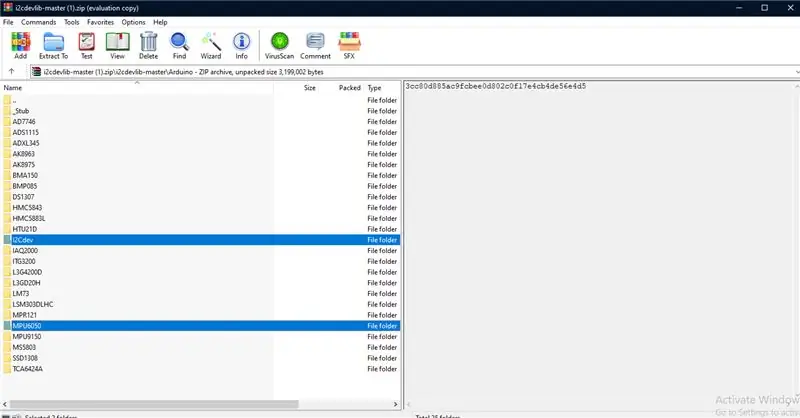
Ouvrez le fichier Zip en klik op het mapje "Arduino". En uit deze Arduino map wil je de mapjes "I2Cdev" en "MPU6050" pakken en in je Arduino library zetten (Program Files > Arduino > library)
Étape 5: Décoder
#comprendre
#include #include #include #include
MPU6050 mpu;
int16_t ax, ay, az, gx, gy, gz;
int16_t accx, accy, accz; int vx, vy; angle de flottement;
//code de lissage inputint readIndex = 0; const int numLectures = 20; int angleReadings[numReadings]; entier = 0; float moyenAngle = 0,0;
int ancienZ = 0;
int nouveauZ = 0;
void setup() { Serial.begin(115200); Fil.begin(); Souris.begin(); mpu.initialize(); if (!mpu.testConnection()) { while (1); }
for (int thisReading = 0; thisReading < numReadings; thisReading++) { angleReadings[thisReading] = 0; } }
boucle vide() {
total = total - angleReadings[readIndex];
angleReadings[readIndex] = angle; total = total + angleReadings[readIndex]; readIndex = readIndex + 1; if (readIndex >= numReadings) { readIndex = 0; }
if (gz > 30000) { Serial.println("Bang"); Clic de souris(); //Tire en faisant reculer le pistolet (coup de doigt) }
//accx, accy, accz;
mpu.getMotion6(&ax, &ay, &az, &gx, &gy, &gz); mpu.getAcceleration(&accx, &accy, &accz); //Série.println(gy); // Serial.println(angle);
ancienZ = nouveauZ;
vx = (gx + 1000) / 150; vy = -(gz - 200) / 150; Mouse.move(vx, vy); retard(20);
Dit stukje code heeft een beetje uitleg nodig omdat je het waarschijnlijk een klein beetje moet aanpassen.
Wat er waarschijnlijk gaat gebeuren is dat je cursor uit zichzelf over je scherm gaat bewegen (van rechts naar links, van boven naar onder of diagonaal) en dit stukje code zorgt er voor dat je curor stil blijft staan input alsge jeftgeen input Je moet de values in in "gx + 1000" en "gz - 200" aanpassen totdat je het resultaat krijgt dat je wil en ik denk dat de values die wil nodig hebt afhankelijk zijn van je scherm resolutie. Als de cursor uit zichzelf van rechts naar links beweegd wil je "gx + x" aanpassen. Als of cursor uit zichzelf van boven naar onder beweegd wil je de "gz - x" aan passen. Als het diagonaal beweegd, dan kies je een van de twee valeurs om aan te passé totdat hij nog maar over een as beweegd en dan pas je de andere aan.
Serial.print("gx = ");
Serial.print(gx); Serial.print(" | gz = "); Serial.print(gz); Serial.print(" | gy = "); Serial.println(gy); if (gx > 32000) { Serial.println("Flick Right"); //Recharger en déplaçant le pistolet vers la droite Keyboard.write('r'); retard (250); } Serial.print("accx = "); Serial.print(accx); Serial.print(" | accy = "); Serial.print(accy); Serial.print(" | accz = "); Serial.println(accz); //travail //angle = atan2((float) (ay - 16384), (float) (ax - 16384)) * (180.0 / PI) * -1; angle = atan2((float) ay, (float) ~ax) * (180,0 / PI); //float angle = atan2((float) ay, (float) -ax) * (180.0 / PI); //Série.println(angle moyen); }
Conseillé:
ITTT : « Zingend Meisje » : 5 étapes
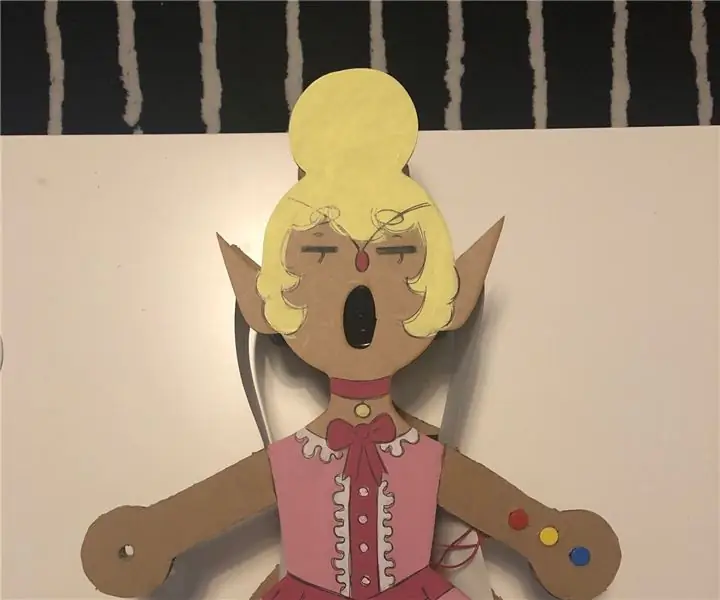
ITTT : « Zingend Meisje » : instructions du projet « zingend meisje » : Hier ga ik vertellen hoe jij zelf een zingen meisje kan maken met arduino. Wat houd het in?: Je gaat een meisje van hout maken die beide haar armen uitsteekt. Aan de ene arm zit een lichtsensor en aan de andere
ITTT L.E.D. : 3 étapes
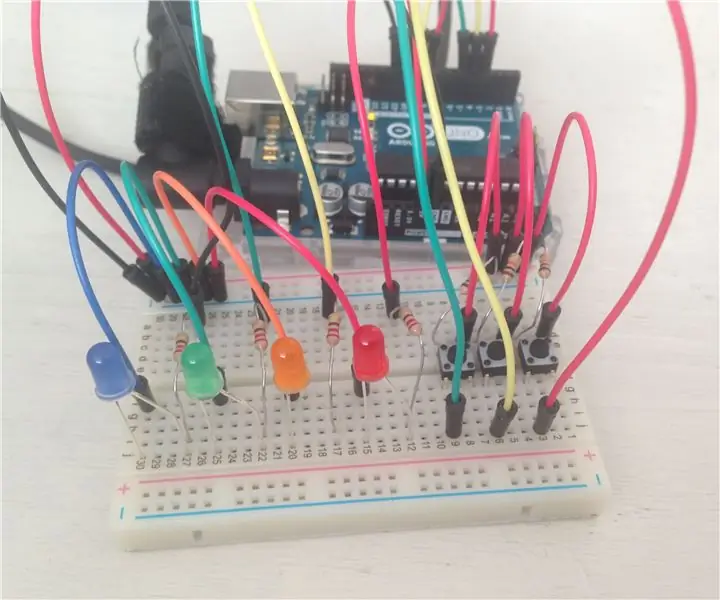
ITTT L.E.D. : Il s'agit d'un projet scolaire pour un cours intitulé If This Then That. Le principe du devoir scolaire est de faire un objet interactif avec l'utilisation de l'électronique principalement l'Arduino Uno. Après une longue période de réflexion, j'ai décidé de faire quelque chose
Projet ITTT 2018 - Terre : 5 étapes

Projet ITTT 2018 | Earth : Bonjour ! Mon école m'a donné un projet dans lequel je devais créer un système interactif à l'aide d'Arduino et le construire dans la vraie vie. J'ai décidé de créer un globe terrestre où votre interaction avec les capteurs et les boutons éclairerait les pays et ferait tourner le globe
Arduino ITTT : 10 étapes
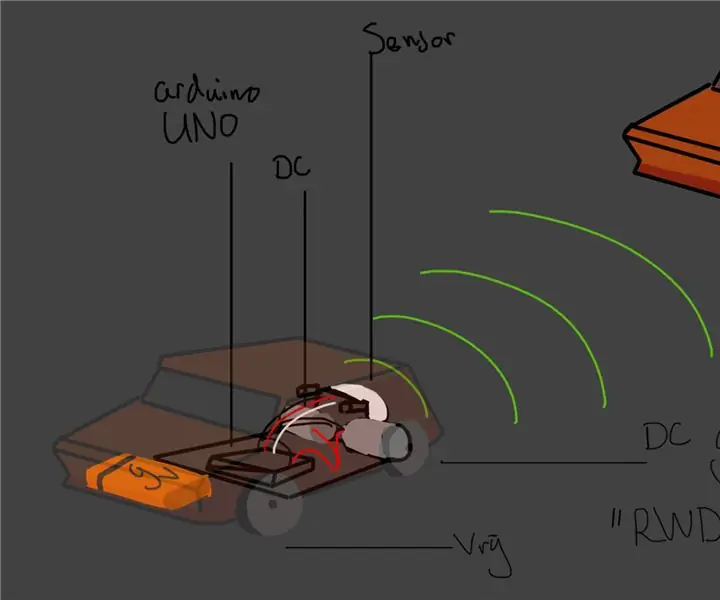
Arduino ITTT: Dit is mijn arduino project:Het autotje wat van je wegrijdt als je ermee wil spelen, heerlijk om kinderen mee te plagen.in de volgende slides laat ik zien hoe ik te werk ben gegaan
Ajout de Motion Control à une horloge de projection : 7 étapes
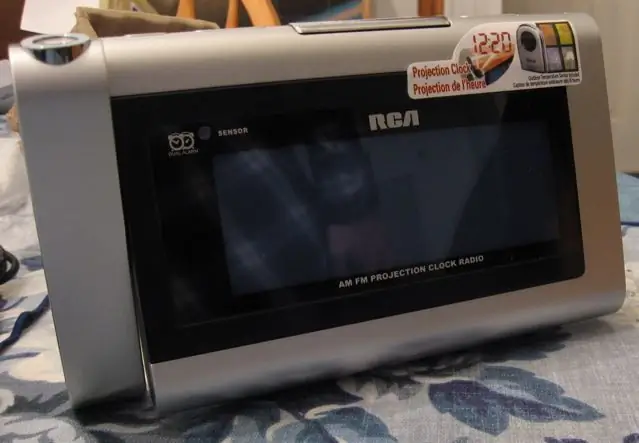
Ajout du contrôle de mouvement à une horloge de projection : Objectif : Ajouter un capteur de mouvement qui éclaire l'horloge la nuit lorsqu'il détecte un mouvement, et rendre la luminosité du rétroéclairage réglable manuellement. Pourquoi : Je n'ai que quelques exigences pour une bonne horloge de chevet. Il doit être facilement visible, mais pas léger
